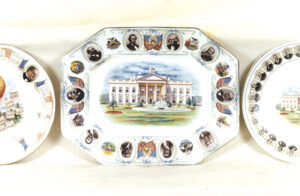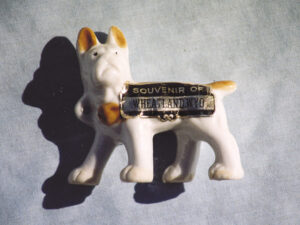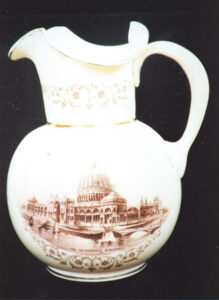 By Robert Reed
By Robert Reed From lovely plates and delicate pitchers to decorative trinket boxes and figural animals, souvenir pottery was proudly displayed in American homes for decades.
Today many of the more interesting pieces, such as a plate honoring the Alaska-Yukon-Pacific Exposition or a ceramic dog labeled Wheatland, Wyo., are the subject of renewed interest among the current generation of collectors.
America’s “golden age” of souvenir pottery began in the 1890s and extended through the 1930s. While numerous items were also produced in the years that followed, production costs and public demand generally reversed positions.
Ironically the country’s first true romance with souvenir pottery was not linked to tourism, but rather the simple appeal of interesting scenes.
Early in the 19th century England’s Josiah Wedgwood was successfully producing wares for the American market which depicted scenes of the Revolutionary War and historical sites.
By the 1820s the entire Staffordshire pottery district of England was busy applying both European and American scenes or “views” to their distinctive pottery. Blue and white transfers produced striking images for buyers who would not likely visit the actual sites themselves.
 Landscapes and modes of transportation were sometimes featured, but a major focus was on specific buildings and other structures of note. Typically such views appeared on plates or serving dishes, but they could also be found on mugs, spittoons, pitchers, creamers, trinket boxes, and even chamber pots.
Landscapes and modes of transportation were sometimes featured, but a major focus was on specific buildings and other structures of note. Typically such views appeared on plates or serving dishes, but they could also be found on mugs, spittoons, pitchers, creamers, trinket boxes, and even chamber pots. Most images were of a deep blue at first in the earlier 1820s but gradually new and improved light blues were used over the next two decades. Still later, in the second half of the 19th century, potters were able to add multiple colors to a basic transfer for an even more striking image.
By the 1850s such unique souvenir pottery was being proudly displayed in the homes of America’s more affluent people. The range of selected topics varied widely from the harbor of New York City to the hamlet of Vevay, Ind. The scene of the “town” of Pittsburgh could be found along side another which highlighted the Deaf and Dumb Asylum of Hartford, Conn.
For some educated Americans it might be relatively easy to recognize buildings of New York’s Crystal Palace if not, perhaps, the Mormon Temple at Nauvoo, Ill. However for the makers of such pottery in England it could be much more of a problem.
 “If most (souvenir pottery) were copied from paintings or from portfolios of prints, all were equally strange to the Staffordshire potter,” noted Los Angeles County Museum curator Gregor Wilcox in “The Concise Encyclopedia of American Antiques.” The potter therefore could be forgiven, “if sometimes he mixed the tiles printed on his views.” One of the first major connections between souvenir pottery and a specific event came with the Centennial celebration of 1876 in Philadelphia. A number of that city’s own buildings appeared on items distributed to those who attended the event including Independence Hall.
“If most (souvenir pottery) were copied from paintings or from portfolios of prints, all were equally strange to the Staffordshire potter,” noted Los Angeles County Museum curator Gregor Wilcox in “The Concise Encyclopedia of American Antiques.” The potter therefore could be forgiven, “if sometimes he mixed the tiles printed on his views.” One of the first major connections between souvenir pottery and a specific event came with the Centennial celebration of 1876 in Philadelphia. A number of that city’s own buildings appeared on items distributed to those who attended the event including Independence Hall. Those pottery souvenirs with historical views were particularly popular at that special event. “Mementos of colonial and revolutionary days were discovered as if seen for the first time at the Centennial Exhibition….by people in great numbers,” observes Wilcox.
By the time the Columbian Exposition arrived in 1893 Americans were totally fascinated with all manner of illustrated souvenir pottery.
That same year the Jones, McDuffee, and Stratton Importing Company of Boston contracted the ever familiar Wedgwood company to produced a series of plates with scenes from the Boston area. In the years that followed the Boston company would commission more than 300 different views on souvenir plates.
Of course, Wedgwood produced a vast number of other scenic plates with American locations in the late 19th century. Souvenir plates and similar pottery also came from the Williams Adams Company, Frank Beardmore and Company, British Anchor Pottery Company, W.T. Copeland and Sons, Royal Doulton, Edwin Knowles China, D.E. McNicol Pottery, Royal Staffordshire Pottery, F. Winkle Company and many others.
Major events of the new 20th century, including the 1904 World’s Fair in St. Louis, naturally lent themselves to great assortments of souvenir pottery. One of the most popular items at that St. Louis event was a simple souvenir cup and saucer.
A few years later visitors to the nation’s capitol in Washington could find a presidential platter which featured the White House and 10 presidents including William McKinley. On the reverse the platter was marked “La Francaise Porcelain.”
Elsewhere in the country during the early 1900s items were as diverse as a pottery Old Oaken Bucket in Scituate, Maine, or a Mayflower Arriving advertising tile for a Boston company celebrating its 100th birthday which sold over 12,000 copies.
A good example of the diversity of such souvenir pottery early in the 20th century came from an eastern newspaper advertisement. It offered a full line of souvenirs including, “toothpick holders, pin trays, ash trays, vases, baskets, cups, saucers, creamers, and boxes.” All items were 25 cents each.
By the 1920s “patriotic and preservation groups were restoring and maintaining historic sites” throughout the United States according to Arene Burgess, author of engaging book, “A Collector’s Guide to Souvenir Plates.” “The souvenir stand became an intrinsic part of almost every tourist attraction.”
During the Roaring Twenties and the decade which followed, travelers could find a blue and white plate with floral border promoting Mechanic Island or something depicting the Women’s League Building at the University of Michigan. They could pick-up a pitcher depicting the fabled House of Seven Gables or a clearly marked ashtray from Moose Jaw in Canada.
The 1939 World’s Fair in New York City was the site of an amazing array of souvenir pottery ranging from various sized teapots and pitchers to hand-painted plates depicting the skyline of the Big Apple.
Certainly a great deal of souvenir pottery was produced in later years, especially plates which could be proudly propped up on cupboard shelves or hung on dining room walls. However the variety and quality seldom rivaled that which had been produced in such great numbers during its golden age.
Today souvenir pottery in unique forms such as animal figurals and structures are highly prized, along with images of buildings and other construction which no longer exists.
Recommended reading:
“Collector’s Guide to Souvenir China” by Laurence Williams (Schiffer Publishing).
“A Collector’s Guide to Souvenir Plates” by Arene Burgess (Schiffer Publishing).
Captions:
The Government Building souvenir pottery pitcher, ca. 1860s. Height 9.25 inches. (Gene Harris Auction Center.)
Souvenir pottery dog with Wheatland, Wyo., paper label.
Presidential platter souvenir pottery marked La Francaise Porcelain, early 1900s; 14 inches. (Gene Harris Auction Center.)















Follow Us